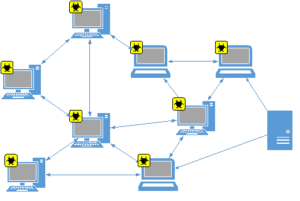Evaluating Vulnerabilities
After identifying potential threats, the next step is to evaluate the vulnerabilities present in the system components. This includes analyzing software vulnerabilities, weak authentication mechanisms, misconfigured systems, and inadequate security controls.
Analyzing Risks
Once vulnerabilities are identified, it’s crucial to analyze the risks associated with each vulnerability. This involves assessing the likelihood of an attack occurring and the potential impact it may have on the system, data, and operations.
Implementing Countermeasures
Based on the risk analysis, appropriate countermeasures should be implemented to mitigate the identified threats and vulnerabilities. This may include deploying firewalls, intrusion detection systems, antivirus software, and conducting regular security patches and updates.
Common Botnet Threats
Botnets can be used for various malicious activities. Here are some of the most common threats posed by botnets:
Distributed Denial-of-Service (DDoS) Attacks
Botnets are often used to launch DDoS attacks, where a large number of devices flood a target system or network with traffic, rendering it inaccessible to legitimate users. These attacks can disrupt online services, cause financial losses, and tarnish an organization’s reputation.
Malware Distribution and Propagation
Botnets serve as an effective means for distributing malware to a wide range of devices. Malware-infected bots can be used to propagate and spread malicious software, including ransomware, spyware, and banking Trojans.
Credential Theft and Identity Fraud
Botnets can harvest sensitive information by capturing login credentials, credit card details, and personal data from compromised devices. This information can then be used for identity theft, financial fraud, or unauthorized access to systems and accounts.

Mitigating Botnet Threats
To effectively mitigate botnet threats, organizations can adopt the following security measures:
Network Segmentation and Isolation
Implementing network segmentation and isolating critical systems helps contain the spread of botnet infections. By separating networks into distinct segments and controlling communication between them, organizations can limit the impact of botnet attacks.
Intrusion Detection and Prevention Systems
Deploying robust intrusion detection and prevention systems can help detect botnet activity in real-time. These systems analyze network traffic, identify suspicious patterns, and take proactive measures to block or mitigate botnet-related threats.
Secure Configuration and Patch Management
Maintaining secure configurations for all devices and regularly applying security patches and updates is crucial in preventing botnet infections. This includes using strong passwords, disabling unnecessary services, and keeping software up to date with the latest security patches.
User Education and Awareness
Educating users about safe browsing habits, email phishing scams, and the risks associated with clicking on suspicious links or downloading unknown attachments can significantly reduce the chances of botnet infections. Regular security awareness training and reminders about best practices are essential.
Read this Sample: Threat modelling of botnets
Case Studies: Successful Botnet Defense Strategies
Examining real-world examples of successful botnet defense strategies can provide valuable insights into effective mitigation techniques. Here are two notable case studies:
Proactive Monitoring and Incident Response
A financial institution implemented a proactive monitoring system that analyzed network traffic and detected anomalous botnet activities. By swiftly responding to detected threats and taking down command and control servers, the institution successfully mitigated the botnet’s impact and minimized potential data breaches.
Collaborative Efforts and Information Sharing
A group of cybersecurity organizations formed a collaborative alliance to share threat intelligence and coordinate efforts against botnets. By pooling resources, they were able to identify and dismantle several large-scale botnets. This collaborative approach facilitated timely information sharing, enabling participating organizations to proactively defend against botnet threats.









